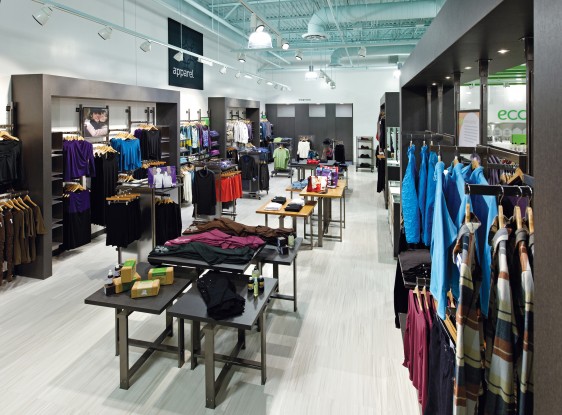Putting your products in the best light: How LED lighting can make all the difference
04, Mar. 2013
Interior Image of the Jump designed terra20, currently open in Ottawa’s Pinecrest Centre.
Information originally appeared in the article “LED Lighting for Retail Stores: How It Improves Sales” on Retail Lighting and Design’s website.
In the planning of any retail space, lighting offers its own set of challenges. Retail lighting not only needs to brightly illuminate store interiors and create an enjoyable consumer atmosphere, it also needs to be set up as efficiently as possible to reduce energy costs. Lighting traditionally makes up a huge part of monthly energy bills. The U.S. Department of Energy estimates that 40% of American retailers’ high-energy bills are due to their store lighting. Research has also shown that outdated stores do fewer sales when proper lighting is not used.
One way a growing number of retailers – including Starbucks and more recently Walmart – are solving this issue is by installing LED lighting systems in new and existing locations. LED technology provides energy savings due to the low voltage required, consuming less power and emitting no heat. The average LED fixture also lasts about six years longer than conventional lighting and is expected to cut down maintenance costs by 30% per year. Therefore, each store that uses energy efficient lighting is expected to reduce its energy costs by 40% annually.
In addition to their environmental benefits, LEDs produce a high illumination and directional lighting for a more product specific focus that guides consumer attention. This quality of lighting helps customers notice small details, enhancing specific aspects of each product and creating a more contemporary look and feel to the environment.
Jump recently designed a lighting scheme for terra20 utilizing predominantly LED lighting fixtures. The warm, flattering illumination adds the perfect finishing touch to the sustainably minded interior. Through careful specifications and controlled use in each merchandise category, Jump was also able to bring the lighting usage to 1.1 watt per square foot, exceeding the minimum code requirements by 25% and demonstrating the savings possible by adopting LED technology.
The biggest argument against LED lighting remains its significantly higher upfront-cost compared to traditional options. While long-term savings are proven to make the adoption to LED viable, the initial price continues to scare some retailers – the average LED fixture costs as much as ten times more than a traditional incandescent model.
Overall, lighting is one of the most important aspects of the customer experience, something retailers often overlook. Despite the up-front investment, the benefits and effectiveness of high-quality LED lighting make adoption to the technology something any retailer should consider over the next few years.
